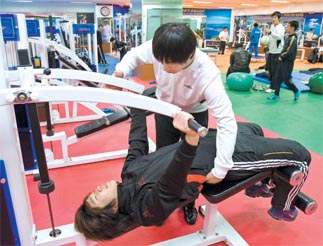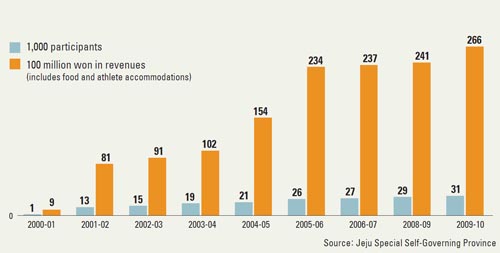Korea’s athletes fly south for the winter

Athletes from Dankook University and Cheonan Jeil High School practice at Kangchanghak Stadium in Seogwipo. A snow-covered Mount Halla is visible in the distance. By Shin Dong-yeon
But over the last decade, things have changed. The tourists may not be back, but they’ve been replaced with another, perhaps more lucrative, group: Korea’s athletes and their support staff. Seogwipo has managed to become a prime spot for winter training.
Buses for Korean football teams line the streets of downtown. From November until March, this city with a population of 155,000 plans to host 20 events with 1,500 teams and about 35,000 athletes. The athletes’ accommodations alone will bring in about 30 billion won ($25.8 million) this season, the city estimates.

Above, manager-turned-Seogwipo booster Sul Dong-sik, left, talks with Ulsan Hyundai Tigers manager Kim Ho-gon on a field in the city.
“Seogwipo has the warmest temperatures in Korea, and so it’s bound to have the greatest training conditions,” said Kim Ho-gon, manager of the Ulsan Hyundai Tigers football team. “Recently, many pro league teams have also started to come here to train. Teams can train here for about two weeks at a time, which cuts down on time for practice and expenses compared to going abroad for games.”
Seogwipo now has 14 football fields, five with natural grass and nine with artificial grass. After construction of the new winter training center is completed, there will be a total of 17 football fields.

Above, an injured athlete goes through rehabilitation training at the Jeju World Cup Stadium’s free sports medicine clinic. By Shin Dong-yeon
Airlines and rental car companies are providing 40 and 50 percent discounts on their tickets and services, respectively. There are also free shuttle buses to transport all athletes from the airport to their accommodations.
The city foots the bill for health care for athletes who injure themselves at the Seogwipo W Sports Clinic in Jeju World Cup Stadium. Volunteers are on call there to treat injuries, and the clinic is equipped with cutting-edge laser technology. They treat about 200 athletes a day.
“By the end of this month, the players from Chung-Ang University, Yonsei University and Korea University plan on training down here,” said basketball training coach Jang Ki-dong. “Even a pro league team from China will be joining us in the beginning of February.”
One fitness center has a 50-meter (164-foot) pool with 10 lanes, half of them set aside for athletes and the others open to club members. Still, the pool often runs out of room, reflecting why some believe Seogwipo’s efforts to bring in athletes have been too successful.

The man Seogwipo residents have to thank - and blame - for the increase in visitors is Sul Dong-sik. In the winter of 1999, Sul became the football coach at Seogwipo High School. Originally from Cheongju, he played for the football teams at Seongsil High School and Dankook University, but quickly retired from sports after an injury. He started a wedding photography office and saved some money, acquiring a reputation for having smart business sense as well as athleticism.
It was Sul who first realized that the town was the perfect setting for winter training. He began to invite his fellow football coaches from junior high and high schools on the mainland to begin training here. Many declined the invitation; still, Sul worked hard to look after the team members who did come to train, and slowly word began to spread about Seogwipo.
During the 2002 World Cup, manager Guus Hiddink brought the Korean national team to Seogwipo for training.
At the time, Hiddink, whose team stayed at the Paradise Hotel, said, “Seogwipo is really a beautiful place and the perfect place to train. You can’t get this kind of fantastic scenery anywhere else in the world.”
As the area began to build its reputation internationally, everything began to change. By that time, Sul had secured the agreement of the mayor of Seogwipo, Kang Sang-ju, to promote the city formally for spring training.
Kang helped commission new football fields in areas where there once had been just breezy green fields. The mayor was supportive of Sul’s ideas, and the locals began to cooperate as the winter practice games grew popular.
About 70 football teams are in Seogwipo this year. Sul is always there to check up on their daily practice and training assignments. If there are problems with lodging or food, he’s the one to mediate and make sure the problems are solved. His cell phone is always ringing, and around the beginning of every year he’s constantly exhausted from picking teams, but he finds the experience rewarding.
“If the facilities here improve greatly and attract more Japanese and Chinese pro league teams, then the three countries could hold the winter leagues here,” said Sul. “By the time that happens, Seogwipo will become the mecca for winter training for the first time ever.”
The help of locals and Sul’s devotion and foresight transformed Seogwipo. The city has declared 2010 “The Year of a New Leap,” to celebrate the 10th anniversary of the start of the winter training project.
With that initiative comes a demanding reviewing of areas the city can improve. The city sent employees to Namhae County in South Gyeongsang, Kangjin and Mokpo in South Jeolla and Taebaek, Gangwon, to learn from their competitors. They also benchmarked their findings against international destinations such as Kyushu, Japan, and Kunming, China.
They found Seogwipo’s climate and facilities were far superior to other cities, but that the other destinations were catching up in infrastructure and cost. Their goals now are to expand their indoor gymnasiums and track and field and swimming facilities.
Most recently, Jeju’s sports division created a task force made up of 60 people divided into seven different groups, assigned to everything from field support to flu shot duty. The task force uses a briefing room in front of Jeju World Cup Stadium.
What started with Sul begging his colleagues to visit is now thoroughly systemized. Every year since 2006, government officials have met with coaches one-on-one and worked hard on promotional material.
The Ministry of Public Administration and Security has acknowledged these efforts. In November, eight officials from the sports division of the Jeju Island government were honored for their contributions in booking 8,114 sports teams and 180,278 athletes for training, bringing in approximately 145.5 billion won over the course of the 10-year project - quite an accomplishment for a quiet island town.
By Jung Young-jae [estyle@joongang.co.kr]
Related Korean Article
겨울 전지훈련 메카 서귀포 르포
제주 서귀포의 겨울은 적요했다. 관광객이 사라진 한라산 남녘에 빨간 동백꽃만 말없이 피었다 툭툭 떨어졌다.
감귤 수확마저 끝나 사람들은 하릴없이 시간을 보냈다. 어쩌다 서귀포를 들르는 관광객들도 천지연폭포와 외돌개를 쓱 둘러보고는 야속하게 제주시로 올라가 버렸다.
2010년 겨울, 서귀포는 활기가 넘치다 못해 뜨끈뜨끈하다. 스포츠가 도시를 탈바꿈시켰다. 서귀포가 ‘겨울 전지훈련의 메카’로 재탄생한 것이다.
요즘 서귀포 시내에서 가장 많이 볼 수 있는 차량은 전국에서 몰려온 축구단 수송 버스다. 서귀포시는 올겨울(2009년 11월∼2010년 3월) 20개 종목, 1500여 개 팀, 3만5000명의 전지훈련 유치 목표를 세웠다. 이들이 먹고, 자고, 씻고, 돌아다니는 데 쓰는 돈은 모두 서귀포에 뿌려진다.
서귀포시가 계산한 올겨울 전지훈련 유치 경제효과는 300억원이지만 이는 오로지 선수단의 숙식비용만 잡은 것이다. 실제는 이를 훨씬 웃돈다. 학교 팀의 경우 보통 선수 한 명당 두 명의 학부모와 관계자가 따라 온다. 이들은 선수들의 훈련을 참관하는 것 외에는 딱히 할 일이 없다. 그래서 밤에는 끼리끼리 어울려 술잔을 기울이고, 휴식일에는 렌터카를 빌려 관광과 골프를 하고, 감귤과 옥돔을 산다. 이런 것들을 모두 합치면 올겨울 전지훈련단이 서귀포에 뿌리고 갈 돈은 1000억원을 훌쩍 넘어선다는 계산이 나온다.
누가, 언제, 어떻게 서귀포에 ‘1000억원짜리 선물’을 안겨줬을까. 그 비밀을 찾아 제주행 비행기에 올랐다.
사용료 없어요. 감귤도 물도 맘껏 드세요
1월 13일 저녁 제주공항에 내렸다. 이날 제주도에는 엄청난 폭설이 쏟아졌다. 제주시에서 서귀포로 내려가는 도로들이 눈밭으로 변했다. 600번 리무진 공항버스도 가다가 멈춰 체인을 감아야 할 정도였다. ‘내일 취재와 사진 촬영을 제대로 할 수 있을까’ 걱정 속에 잠을 청했다.
다음 날 말끔하게 날이 갰다. 프로축구단 울산 현대가 훈련하고 있는 시민구장을 찾았다. 거짓말처럼 눈이 녹아 파릇파릇한 잔디 구장이 모습을 드러내고 있었다. 김호곤 울산 현대 감독은 “서귀포는 국내에서 날씨가 가장 따뜻하고 훈련 여건도 좋아 최근에는 프로 팀들도 자주 찾는다. 서귀포에서 보름 정도 훈련을 하면 해외 전지훈련 일정을 줄일 수 있어 경비 절감이 된다”고 말했다.
현재 서귀포에는 모두 14개의 축구장(천연잔디 5면, 인조잔디 9면)이 있다. 남원읍에 짓고 있는 전지훈련센터(축구장 3면)가 올해 완공되면 축구장은 17개로 늘어난다. 실내체육관은 중문동의 국민체력센터를 비롯해 5개가 있다. 테니스 코트는 17면이 있는데 그중 3개 면에는 지붕을 씌워 전천후 훈련이 가능하게 했다.
서귀포시는 이 모든 시설에 대해 사용료를 일절 받지 않는다. 그뿐 아니라 전지훈련 선수단에는 싱싱한 감귤과 삼다수를 제공한다. 항공료는 최대 40%, 렌터카 비용은 50%까지 할인해 준다. 자체 버스가 없는 수영·육상 등 개인 종목 선수들을 위해서는 공항과 숙소를 오가는 셔틀버스도 운행한다.
훈련하다 다친 선수들을 위한 무료 진료 프로그램도 있다. 제주월드컵경기장 내 서귀포W스포츠클리닉에 가면 대한선수트레이너협회(KATA) 소속 자원봉사자들이 기다리고 있다. 이들은 레이저 치료기 등 첨단 장비를 갖추고 하루 200명 정도의 부상 선수들을 치료한다.
한글 원문 기사 보기
겨울 전지훈련 메카 서귀포 르포
제주 서귀포의 겨울은 적요했다. 관광객이 사라진 한라산 남녘에 빨간 동백꽃만 말없이 피었다 툭툭 떨어졌다.
감귤 수확마저 끝나 사람들은 하릴없이 시간을 보냈다. 어쩌다 서귀포를 들르는 관광객들도 천지연폭포와 외돌개를 쓱 둘러보고는 야속하게 제주시로 올라가 버렸다.
2010년 겨울, 서귀포는 활기가 넘치다 못해 뜨끈뜨끈하다. 스포츠가 도시를 탈바꿈시켰다. 서귀포가 ‘겨울 전지훈련의 메카’로 재탄생한 것이다.
요즘 서귀포 시내에서 가장 많이 볼 수 있는 차량은 전국에서 몰려온 축구단 수송 버스다. 서귀포시는 올겨울(2009년 11월∼2010년 3월) 20개 종목, 1500여 개 팀, 3만5000명의 전지훈련 유치 목표를 세웠다. 이들이 먹고, 자고, 씻고, 돌아다니는 데 쓰는 돈은 모두 서귀포에 뿌려진다.
서귀포시가 계산한 올겨울 전지훈련 유치 경제효과는 300억원이지만 이는 오로지 선수단의 숙식비용만 잡은 것이다. 실제는 이를 훨씬 웃돈다. 학교 팀의 경우 보통 선수 한 명당 두 명의 학부모와 관계자가 따라 온다. 이들은 선수들의 훈련을 참관하는 것 외에는 딱히 할 일이 없다. 그래서 밤에는 끼리끼리 어울려 술잔을 기울이고, 휴식일에는 렌터카를 빌려 관광과 골프를 하고, 감귤과 옥돔을 산다. 이런 것들을 모두 합치면 올겨울 전지훈련단이 서귀포에 뿌리고 갈 돈은 1000억원을 훌쩍 넘어선다는 계산이 나온다.
누가, 언제, 어떻게 서귀포에 ‘1000억원짜리 선물’을 안겨줬을까. 그 비밀을 찾아 제주행 비행기에 올랐다.
사용료 없어요. 감귤도 물도 맘껏 드세요
1월 13일 저녁 제주공항에 내렸다. 이날 제주도에는 엄청난 폭설이 쏟아졌다. 제주시에서 서귀포로 내려가는 도로들이 눈밭으로 변했다. 600번 리무진 공항버스도 가다가 멈춰 체인을 감아야 할 정도였다. ‘내일 취재와 사진 촬영을 제대로 할 수 있을까’ 걱정 속에 잠을 청했다.
다음 날 말끔하게 날이 갰다. 프로축구단 울산 현대가 훈련하고 있는 시민구장을 찾았다. 거짓말처럼 눈이 녹아 파릇파릇한 잔디 구장이 모습을 드러내고 있었다. 김호곤 울산 현대 감독은 “서귀포는 국내에서 날씨가 가장 따뜻하고 훈련 여건도 좋아 최근에는 프로 팀들도 자주 찾는다. 서귀포에서 보름 정도 훈련을 하면 해외 전지훈련 일정을 줄일 수 있어 경비 절감이 된다”고 말했다.
현재 서귀포에는 모두 14개의 축구장(천연잔디 5면, 인조잔디 9면)이 있다. 남원읍에 짓고 있는 전지훈련센터(축구장 3면)가 올해 완공되면 축구장은 17개로 늘어난다. 실내체육관은 중문동의 국민체력센터를 비롯해 5개가 있다. 테니스 코트는 17면이 있는데 그중 3개 면에는 지붕을 씌워 전천후 훈련이 가능하게 했다.
서귀포시는 이 모든 시설에 대해 사용료를 일절 받지 않는다. 그뿐 아니라 전지훈련 선수단에는 싱싱한 감귤과 삼다수를 제공한다. 항공료는 최대 40%, 렌터카 비용은 50%까지 할인해 준다. 자체 버스가 없는 수영·육상 등 개인 종목 선수들을 위해서는 공항과 숙소를 오가는 셔틀버스도 운행한다.
훈련하다 다친 선수들을 위한 무료 진료 프로그램도 있다. 제주월드컵경기장 내 서귀포W스포츠클리닉에 가면 대한선수트레이너협회(KATA) 소속 자원봉사자들이 기다리고 있다. 이들은 레이저 치료기 등 첨단 장비를 갖추고 하루 200명 정도의 부상 선수들을 치료한다.










with the Korea JoongAng Daily
To write comments, please log in to one of the accounts.
Standards Board Policy (0/250자)